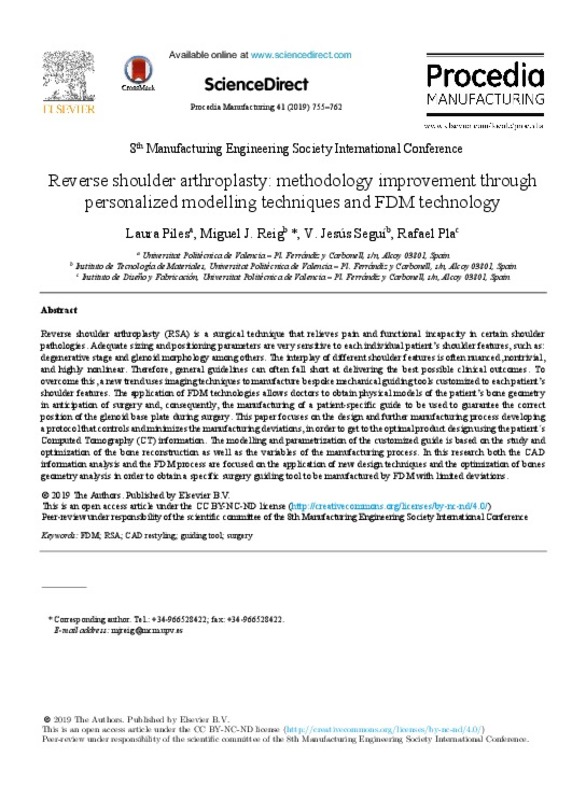JavaScript is disabled for your browser. Some features of this site may not work without it.
Buscar en RiuNet
Listar
Mi cuenta
Estadísticas
Ayuda RiuNet
Admin. UPV
Reverse shoulder arthroplasty: methodology improvement through personalized modelling techniques and FDM technology
Mostrar el registro sencillo del ítem
Ficheros en el ítem
| dc.contributor.author | Piles, Laura
|
es_ES |
| dc.contributor.author | Reig-Pérez, Miguel Jorge
|
es_ES |
| dc.contributor.author | Segui Llinares, Vicente Jesús
|
es_ES |
| dc.contributor.author | Pla-Ferrando, R
|
es_ES |
| dc.date.accessioned | 2021-02-02T04:32:56Z | |
| dc.date.available | 2021-02-02T04:32:56Z | |
| dc.date.issued | 2019 | es_ES |
| dc.identifier.uri | http://hdl.handle.net/10251/160434 | |
| dc.description.abstract | [EN] Reverse shoulder arthroplasty (RSA) is a surgical technique that relieves pain and functional incapacity in certain shoulder pathologies. Adequate sizing and positioning parameters are very sensitive to each individual patient's shoulder features, such as: degenerative stage and glenoid morphology among others. The interplay of different shoulder features is often nuanced, nontrivial, and highly nonlinear. Therefore, general guidelines can often fall short at delivering the best possible clinical outcomes. To overcome this, a new trend uses imaging techniques to manufacture bespoke mechanical guiding tools customized to each patient's shoulder features. The application of FDM technologies allows doctors to obtain physical models of the patient's bone geometry in anticipation of surgery and, consequently, the manufacturing of a patient-specific guide to be used to guarantee the correct position of the glenoid base plate during surgery. This paper focuses on the design and further manufacturing process developing a protocol that controls and minimizes the manufacturing deviations, in order to get to the optimal product design using the patient's Computed Tomography (CT) information. The modelling and parametrization of the customized guide is based on the study and optimization of the bone reconstruction as well as the variables of the manufacturing process. In this research both the CAD information analysis and the FDM process are focused on the application of new design techniques and the optimization of bones geometry analysis in order to obtain a specific surgery guiding tool to be manufactured by FDM with limited deviations. | es_ES |
| dc.description.sponsorship | The authors wish to acknowledge the support and assistance of Dr. Fernando Martínez, Consultant at the Hospital San Juan (Alicante, Spain) for his assistance in the medical analysis of the arthropathy. This work was funded by the Polisabio Funding (UPV-Fisabio 2017). | es_ES |
| dc.language | Inglés | es_ES |
| dc.publisher | Elsevier | es_ES |
| dc.relation.ispartof | Procedia Manufacturing | es_ES |
| dc.rights | Reconocimiento - No comercial - Sin obra derivada (by-nc-nd) | es_ES |
| dc.subject | FDM | es_ES |
| dc.subject | RSA | es_ES |
| dc.subject | CAD restyling | es_ES |
| dc.subject | Guiding tool | es_ES |
| dc.subject | Surgery | es_ES |
| dc.subject.classification | INGENIERIA MECANICA | es_ES |
| dc.subject.classification | INGENIERIA DE LOS PROCESOS DE FABRICACION | es_ES |
| dc.title | Reverse shoulder arthroplasty: methodology improvement through personalized modelling techniques and FDM technology | es_ES |
| dc.type | Artículo | es_ES |
| dc.identifier.doi | 10.1016/j.promfg.2019.09.067 | es_ES |
| dc.relation.projectID | info:eu-repo/grantAgreement/UPV//UPV-FISABIO-2017-003-1606/ | es_ES |
| dc.rights.accessRights | Abierto | es_ES |
| dc.contributor.affiliation | Universitat Politècnica de València. Departamento de Ingeniería Mecánica y de Materiales - Departament d'Enginyeria Mecànica i de Materials | es_ES |
| dc.description.bibliographicCitation | Piles, L.; Reig-Pérez, MJ.; Segui Llinares, VJ.; Pla-Ferrando, R. (2019). Reverse shoulder arthroplasty: methodology improvement through personalized modelling techniques and FDM technology. Procedia Manufacturing. 41:755-762. https://doi.org/10.1016/j.promfg.2019.09.067 | es_ES |
| dc.description.accrualMethod | S | es_ES |
| dc.relation.publisherversion | https://doi.org/10.1016/j.promfg.2019.09.067 | es_ES |
| dc.description.upvformatpinicio | 755 | es_ES |
| dc.description.upvformatpfin | 762 | es_ES |
| dc.type.version | info:eu-repo/semantics/publishedVersion | es_ES |
| dc.description.volume | 41 | es_ES |
| dc.identifier.eissn | 2351-9789 | es_ES |
| dc.relation.pasarela | S\405302 | es_ES |
| dc.contributor.funder | Universitat Politècnica de València | es_ES |
| dc.description.references | Smithers, C. J., Young, A. A., & Walch, G. (2011). Reverse shoulder arthroplasty. Current Reviews in Musculoskeletal Medicine, 4(4), 183-190. doi:10.1007/s12178-011-9097-4 | es_ES |
| dc.description.references | Javaid, M., & Haleem, A. (2018). Additive manufacturing applications in medical cases: A literature based review. Alexandria Journal of Medicine, 54(4), 411-422. doi:10.1016/j.ajme.2017.09.003 | es_ES |
| dc.description.references | D.V.C. Stoffelen, K. Eraly, P. Debeer, The use of 3D printing technology in reconstruction of a severe glenoid defect: a case report with 2.5 years of follow-up, Journal of Shoulder Elbow Surgery, 24 (2015) e218-e222 | es_ES |








